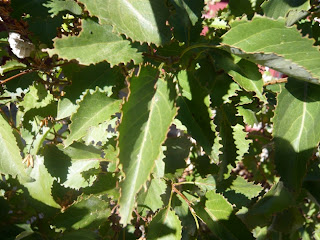 |
| Earlitreat Peaches |
We are just about one week off from picking Earlitreat peaches, the first tree fruit to be harvested at The Orchard. Right on its heels are the apricots. The temperatures this time of year are very close to the temperatures we had last Spring; cool.
Cool weather does not tend to develop the sweetness and flavors that hotter weather does in many of our early fruit. Cool weather may also affect how the pit of stone fruit develops. Sugar content will be low unless temperatures start to rise consistently into the 90's. Total acidity and other flavor factors are also affected. The high temperatures of our desert usually cause our fruits to have very high sugar contents. The salinity of our soils may also increase sugar contents.
 |
| Refractometer |
Sweetness can be measured in fruit and vegetables with a refractometer. This sugar content is usually measured in Brix. This indexes the sugar content (along with other dissolved solids) of the fruit through the refraction of light (the bending of light as it travels through plant juices; the higher the sugar content the more bending of light that occurs). This refraction of light is measured on a scale that can be seen through the adjustable eyepiece of the refractometer (upper right). The Brix scale is calibrated so that each degree Brix represents a 1% increase, by weight of, sucrose in pure water at 25° Celsius.
Refractometers can be purchased from several vendors such as Orchard Valley Supply, Spectrum Technologies, and other online sources.
A few drops of juice are squeezed from the food that you are testing using a garlic press and placed on the prism of the refractometer on the bottom left. If you have a handheld refractometer like the one above you look through the eyepiece and determine the Brix reading. If you have a digital refractometer, you calibrate the refractometer using distilled water, and press a button to have it analyze the sample and determine the Brix reading. Be sure to clean the prism each time a Brix reading is made.
Commercially, farmers can receive more money for what they produce if they exceed the sugar content specified in a contract for the products they produce. However when we "tree ripen" fruit we can consistently get higher sugar contents easily exceeding the "excellent" mark set in Brix tables. For instance apples suitable for the desert can achieve Brix readings over 20. Knowledgable growers will let the consumer know this content to add value to the product being produced.
REFRACTIVE INDEX OF CROP JUICES
CALIBRATED IN % SUCROSE OR °BRIX
Fruit | Poor | Exc. | Veggies | Poor | Exc. |
Apples | 6 | 18 | Asparagus | 2 | 8 |
Avocados | 4 | 10 | Beets | 2 | 12 |
Bananas | 8 | 14 | Broccoli | 6 | 12 |
Cantaloupe | 8 | 16 | Cabbage | 6 | 12 |
Casaba | 8 | 14 | Carrots | 4 | 18 |
Cherries | 6 | 16 | Cauliflower | 4 | 10 |
Coconut | 8 | 14 | Celery | 4 | 12 |
Grapes | 8 | 24 | Corn Stalks | 4 | 20 |
Grapefruit | 6 | 18 | Corn, Sweet | 6 | 24 |
Honeydew | 8 | 14 | Cow Peas | 4 | 12 |
Kumquat | 4 | 10 | Endive | 4 | 10 |
Lemons | 4 | 12 | Escarole | 4 | 10 |
Limes | 4 | 12 | Green Beans | 4 | 10 |
Mangos | 4 | 14 | Kohlrabi | 6 | 12 |
Oranges | 6 | 20 | Lettuce | 4 | 10 |
Papayas | 6 | 22 | Onions | 4 | 10 |
Peaches | 6 | 18 | Parsley | 4 | 10 |
Pears | 6 | 14 | Peanuts | 4 | 10 |
Pineapple | 12 | 22 | Peas, Eng. | 8 | 14 |
Raisins | 60 | 80 | Peas, Field | 4 | 12 |
Rasp. | 6 | 14 | Peppers, Bell | 4 | 12 |
Strawb. | 6 | 16 | Peppers, Hot | 4 | 10 |
Tomatoes | 4 | 12 | Potatoes, Ir. | 3 | 7 |
Waterm. | 8 | 16 | Potatoes, Red | 3 | 7 |
|
|
| Potatoes, Sw. | 6 | 14 |
GRASSES |
|
| Rutabagas | 4 | 12 |
Alfalfa | 4 | 22 | Squash | 6 | 14 |
Grains | 6 | 18 | Turnips | 4 | 10 |






